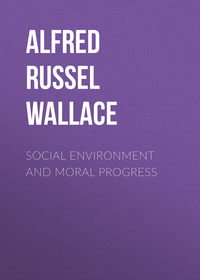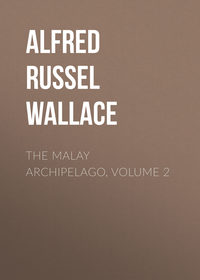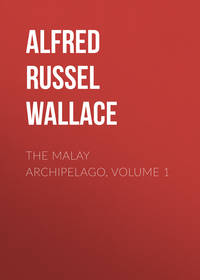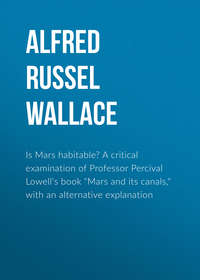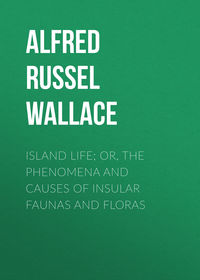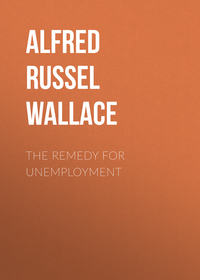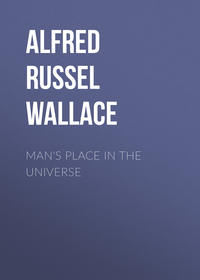 полная версия
полная версияContributions to the Theory of Natural Selection
Now, instead of this beautiful self-acting adjustment, the opposing theory is, that the Creator of the Universe, by a direct act of his Will, so disposed the natural forces influencing the growth of this one species of plant as to cause its nectary to increase to this enormous length; and at the same time, by an equally special act, determined the flow of nourishment in the organization of the moth, so as to cause its proboscis to increase in exactly the same proportion, having previously so constructed the Angræcum that it could only be maintained in existence by the agency of this moth. But what proof is given or suggested that this was the mode by which the adjustment took place? None whatever, except a feeling that there is an adjustment of a delicate kind, and an inability to see how known causes could have produced such an adjustment. I believe I have shown, however, that such an adjustment is not only possible but inevitable, unless at some point or other we deny the action of those simple laws which we have already admitted to be but the expressions of existing facts.
Adaptation brought about by General Laws
It is difficult to find anything like parallel cases in inorganic nature, but that of a river may perhaps illustrate the subject in some degree. Let us suppose a person totally ignorant of Modern Geology to study carefully a great River System. He finds in its lower part, a deep broad channel filled to the brim, flowing slowly through a flat country and carrying out to the sea a quantity of fine sediment. Higher up it branches into a number of smaller channels, flowing alternately through flat valleys and between high banks; sometimes he finds a deep rocky bed with perpendicular walls, carrying the water through a chain of hills; where the stream is narrow he finds it deep, where wide shallow. Further up still, he comes to a mountainous region, with hundreds of streams and rivulets, each with its tributary rills and gullies, collecting the water from every square mile of surface, and every channel adapted to the water that it has to carry. He finds that the bed of every branch, and stream, and rivulet, has a steeper and steeper slope as it approaches its sources, and is thus enabled to carry off the water from heavy rains, and to bear away the stones and pebbles and gravel, that would otherwise block up its course. In every part of this system he would see exact adaptation of means to an end. He would say, that this system of channels must have been designed, it answers its purpose so effectually. Nothing but a mind could have so exactly adapted the slopes of the channels, their capacity, and frequency, to the nature of the soil and the quantity of the rainfall. Again, he would see special adaptation to the wants of man, in broad quiet navigable rivers flowing through fertile plains that support a large population, while the rocky streams and mountain torrents, were confined to those sterile regions suitable only for a small population of shepherds and herdsmen. He would listen with incredulity to the Geologist, who assured him, that the adaptation and adjustment he so admired was an inevitable result of the action of general laws. That the rains and rivers, aided by subterranean forces, had modelled the country, had formed the hills and valleys, had scooped out the river beds, and levelled the plains;—and it would only be after much patient observation and study, after having watched the minute changes produced year by year, and multiplying them by thousands and ten thousands, after visiting the various regions of the earth and seeing the changes everywhere going on, and the unmistakable signs of greater changes in past times,—that he could be made to understand that the surface of the earth, however beautiful and harmonious it may appear, is strictly due in every detail to the action of forces which are demonstrably self-adjusting.
Moreover, when he had sufficiently extended his inquiries, he would find, that every evil effect which he would imagine must be the result of non-adjustment does somewhere or other occur, only it is not always evil. Looking on a fertile valley, he would perhaps say—“If the channel of this river were not well adjusted, if for a few miles it sloped the wrong way, the water could not escape, and all this luxuriant valley, full of human beings, would become a waste of waters.” Well, there are hundreds of such cases. Every lake is a valley “wasted by water,” and in some cases (as the Dead Sea) it is a positive evil, a blot upon the harmony and adaptation of the surface of the earth. Again, he might say—“If rain did not fall here, but the clouds passed over us to some other regions, this verdant and highly cultivated plain would become a desert.” And there are such deserts over a large part of the earth, which abundant rains would convert into pleasant dwelling-places for man. Or he might observe some great navigable river, and reflect how easily rocks, or a steeper channel in places, might render it useless to man;—and a little inquiry would show him hundreds of rivers in every part of the world, which are thus rendered useless for navigation.
Exactly the same thing occurs in organic nature. We see some one wonderful case of adjustment, some unusual development of an organ, but we pass over the hundreds of cases in which that adjustment and development do not occur. No doubt when one adjustment is absent another takes its place, because no organism can continue to exist that is not adjusted to its environment; and unceasing variation with unlimited powers of multiplication, in most cases, furnish the means of self-adjustment. The world is so constituted, that by the action of general laws there is produced the greatest possible variety of surface and of climate; and by the action of laws equally general, the greatest possible variety of organisms have been produced, adapted to the varied conditions of every part of the earth. Tho objector would probably himself admit, that the varied surface of the earth—the plains and valleys, the hills and mountains, the deserts and volcanoes, the winds and currents, the seas and lakes and rivers, and the various climates of the earth—are all the results of general laws acting and re-acting during countless ages; and that the Creator does not appear to guide and control the action of these laws—here determining the height of a mountain, there altering the channel of a river—here making the rains more abundant, there changing the direction of a current. He would probably admit that the forces of inorganic nature are self-adjusting, and that the result necessarily fluctuates about a given mean condition (which is itself slowly changing), while within certain limits the greatest possible amount of variety is produced. If then a “contriving mind” is not necessary at every step of the process of change eternally going on in the inorganic world, why are we required to believe in the continual action of such a mind in the region of organic nature? True, the laws at work are more complex, the adjustments more delicate, the appearance of special adaptation more remarkable; but why should we measure the creative mind by our own? Why should we suppose the machine too complicated, to have been designed by the Creator so complete that it would necessarily work out harmonious results? The theory of “continual interference” is a limitation of the Creator’s power. It assumes that he could not work by pure law in the organic, as he has done in the inorganic world; it assumes that he could not foresee the consequences of the laws of matter and mind combined—that results would continually arise which are contrary to what is best, and that he has to change what would otherwise be the course of nature, in order to produce that beauty, and variety, and harmony, which even we, with our limited intellects, can conceive to be the result of self-adjustment in a universe governed by unvarying law. If we could not conceive the world of nature to be self-adjusting and capable of endless development, it would even then be an unworthy idea of a Creator, to impute the incapacity of our minds to him; but when many human minds can conceive, and can even trace out in detail some of the adaptations in nature as the necessary results of unvarying law, it seems strange that, in the interests of religion, any one should seek to prove that the System of Nature, instead of being above, is far below our highest conceptions of it. I, for one, cannot believe that the world would come to chaos if left to Law alone. I cannot believe that there is in it no inherent power of developing beauty or variety, and that the direct action of the Deity is required to produce each spot or streak on every insect, each detail of structure in every one of the millions of organisms that live or have lived upon the earth. For it is impossible to draw a line. If any modifications of structure could be the result of law, why not all? If some self-adaptations could arise, why not others? If any varieties of colour, why not all the varieties we see? No attempt is made to explain this, except by reference to the fact that “purpose” and “contrivance” are everywhere visible, and by the illogical deduction that they could only have arisen from the direct action of some mind, because the direct action of our minds produces similar “contrivances”; but it is forgotten that adaptation, however produced, must have the appearance of design. The channel of a river looks as if made for the river, although it is made by it; the fine layers and beds in a deposit of sand, often look as if they had been sorted, and sifted, and levelled, designedly; the sides and angles of a crystal exactly resemble similar forms designed by man; but we do not therefore conclude that these effects have, in each individual case, required the directing action of a creative mind, or see any difficulty in their being produced by natural Law.
Beauty in Nature
Let us, however, leave this general argument for a while, and turn to another special case, which has been appealed to as conclusive against Mr. Darwin’s views. “Beauty” is, to some persons, as great a stumbling-block as “contrivance.” They cannot conceive a system of the Universe, so perfect, as necessarily to develop every form of Beauty, but suppose that when anything specially beautiful occurs, it is a step beyond what that system could have produced, something which the Creator has added for his own delectation.
Speaking of the Humming Birds, the Duke of Argyll says: “In the first place, it is to be observed of the whole group, that there is no connection which can be traced or conceived, between the splendour of the humming birds and any function essential to their life. If there were any such connection, that splendour could not be confined, as it almost exclusively is, to only one sex. The female birds are, of course, not placed at any disadvantage in the struggle for existence by their more sombre colouring.” And after describing the various ornaments of these birds, he says: “Mere ornament and variety of form, and these for their own sake, is the only principle or rule with reference to which Creative Power seems to have worked in these wonderful and beautiful birds.... A crest of topaz is no better in the struggle for existence than a crest of sapphire. A frill ending in spangles of the emerald is no better in the battle of life than a frill ending in spangles of the ruby. A tail is not affected for the purposes of flight, whether its marginal or its central feathers are decorated with white.... Mere beauty and mere variety, for their own sake, are objects which we ourselves seek when we can make the Forces of Nature subordinate to the attainment of them. There seems to be no conceivable reason why we should doubt or question, that these are ends and aims also in the forms given to living organisms” (“Reign of Law,” p. 248).
Here the statement that “no connection can be conceived between the splendour of the humming birds and any function essential to their life,” is met by the fact, that Mr. Darwin has not only conceived but has shown, both by observation and reasoning, how beauty of colour and form may have a direct influence on the most important of all the functions of life, that of reproduction. In the variations to which birds are subject, any more brilliant colour than usual would be attractive to the females, and would lead to the individuals so adorned leaving more than the average number of offspring. Experiment and observation have shown, that this kind of sexual selection does actually take place; and the laws of inheritance would necessarily lead to the further development of any individual peculiarity that was attractive, and thus the splendour of the humming birds is directly connected with their very existence. It is true that “a crest of topaz may be no better than a crest of sapphire,” but either of these may be much better than no crest at all; and the different conditions under which the parent form must have existed in different parts of its range, will have determined different variations of tint, either of which were advantageous. The reason why female birds are not adorned with equally brilliant plumes is sufficiently clear; they would be injurious, by rendering their possessors too conspicuous during incubation. Survival of the fittest, has therefore favoured the development of those dark green tints on the upper surface of so many female humming birds, which are most conducive to their protection while the important functions of hatching and rearing the young are being carried on. Keeping in mind the laws of multiplication, variation, and survival of the fittest, which are for ever in action, these varied developments of beauty and harmonious adjustments to conditions, are not only conceivable but demonstrable results.
The objection I am now combating is solely founded on the supposed analogy of the Creator’s mind to ours, as regards the love of Beauty for its own sake; but if this analogy is to be trusted, then there ought to be no natural objects which are disagreeable or ungraceful in our eyes. And yet it is undoubtedly the fact that there are many such. Just as surely as the Horse and Deer are beautiful and graceful, the Elephant, Rhinoceros, Hippopotamus, and Camel are the reverse. The majority of Monkeys and Apes are not beautiful; the majority of Birds have no beauty of colour; a vast number of Insects and Reptiles are positively ugly. Now, if the Creator’s mind is like ours, whence this ugliness? It is useless to say “that is a mystery we cannot explain,” because we have attempted to explain one-half of creation by a method that will not apply to the other half. We know that a man with the highest taste and with unlimited wealth, practically does abolish all ungraceful and disagreeable forms and colours from his own domains. If the beauty of creation is to be explained by the Creator’s love of beauty, we are bound to ask why he has not banished deformity from the earth, as the wealthy and enlightened man does from his estate and from his dwelling; and if we can get no satisfactory answer, we shall do well to reject the explanation offered. Again, in the case of flowers, which are always especially referred to, as the surest evidence of beauty being an end of itself in creation, the whole of the facts are never fairly met. At least half the plants in the world have not bright-coloured or beautiful flowers; and Mr. Darwin has lately arrived at the wonderful generalization, that flowers have become beautiful solely to attract insects to assist in their fertilization. He adds, “I have come to this conclusion from finding it an invariable rule, that when a flower is fertilized by the wind it never has a gaily-coloured corolla.” Here is a most wonderful case of beauty being useful, when it might be least expected. But much more is proved; for when beauty is of no use to the plant it is not given. It cannot be imagined to do any harm. It is simply not necessary, and is therefore withheld! We ought surely to have been told how this fact is consistent with beauty being “an end in itself,” and with the statement of its being given to natural objects “for its own sake.”
How new Forms are produced by Variation and Selection
Let us now consider another of the popular objections which the Duke of Argyll thus sets forth:—
“Mr. Darwin does not pretend to have discovered any law or rule, according to which new Forms have been born from old Forms. He does not hold that outward conditions, however changed, are sufficient to account for them.... His theory seems to be far better than a mere theory—to be an established scientific truth—in so far as it accounts, in part at least, for the success and establishment and spread of new Forms when they have arisen. But it does not even suggest the law under which, or by or according to which, such new Forms are introduced. Natural Selection can do nothing, except with the materials presented to its hands. It cannot select except among the things open to selection.... Strictly speaking, therefore, Mr. Darwin’s theory is not a theory on the Origin of Species at all, but only a theory on the causes which lead to the relative success or failure of such new forms as may be born into the world.” (“Reign of Law,” p. 230.)
In this, and many other passages in his work, the Duke of Argyll sets forth his idea of Creation as a “Creation by birth,” but maintains that each birth of a new form from parents differing from itself, has been produced by a special interference of the Creator, in order to direct the process of development into certain channels; that each new species is in fact a “special creation,” although brought into existence through the ordinary laws of reproduction. He maintains therefore, that the laws of multiplication and variation cannot furnish the right kinds of materials at the right times for natural selection to work on. I believe, on the contrary, that it can be logically proved from the six axiomatic laws before laid down, that such materials would be furnished; but I prefer to show there are abundance of facts which demonstrate that they are furnished.
The experience of all cultivators of plants and breeders of animals shows, that when a sufficient number of individuals are examined, variations of any required kind can always be met with. On this depends the possibility of obtaining breeds, races, and fixed varieties of animals and plants; and it is found, that any one form of variation may be accumulated by selection, without materially affecting the other characters of the species; each seems to vary in the one required direction only. For example, in turnips, radishes, potatoes, and carrots, the root or tuber varies in size, colour, form, and flavour, while the foliage and flowers seem to remain almost stationary; in the cabbage and lettuce, on the contrary, the foliage can be modified into various forms and modes of growth, the root, flower, and fruit remaining little altered; in the cauliflower and brocoli the flower heads vary; in the garden pea the pod only changes. We get innumerable forms of fruit in the apple and pear, while the leaves and flowers remain undistinguishable; the same occurs in the gooseberry and garden currant. Directly however, (in the very same genus) we want the flower to vary in the Ribes sanguineum, it does so, although mere cultivation for hundreds of years has not produced marked differences in the flowers of Ribes grossularia. When fashion demands any particular change in the form or size, or colour of a flower, sufficient variation always occurs in the right direction, as is shown by our roses, auriculas, and geraniums; when, as recently, ornamental leaves come into fashion sufficient variation is found to meet the demand, and we have zoned pelargoniums, and variegated ivy, and it is discovered that a host of our commonest shrubs and herbaceous plants have taken to vary in this direction just when we want them to do so! This rapid variation is not confined to old and well-known plants subjected for a long series of generations to cultivation, but the Sikim Rhododendrons, the Fuchsias, and Calceolarias from the Andes, and the Pelargoniums from the Cape are equally accommodating, and vary just when and where and how we require them.
Turning to animals we find equally striking examples. If we want any special quality in any animal we have only to breed it in sufficient quantities and watch carefully, and the required variety is always found, and can be increased to almost any desired extent. In Sheep, we get flesh, fat, and wool; in Cows, milk; in Horses, colour, strength, size, and speed; in Poultry, we have got almost any variety of colour, curious modifications of plumage, and the capacity of perpetual egg-laying. In Pigeons we have a still more remarkable proof of the universality of variation, for it has been at one time or another the fancy of breeders to change the form of every part of these birds, and they have never found the required variations absent. The form, size, and shape of bill and feet, have been changed to such a degree as is found only in distinct genera of wild birds; the number of tail feathers has been increased, a character which is generally one of the most permanent nature, and is of high importance in the classification of birds; and the size, the colour, and the habits, have been also changed to a marvellous extent. In Dogs, the degree of modification and the facility with which it is effected, is almost equally apparent. Look at the constant amount of variation in opposite directions that must have been going on, to develop the poodle and the greyhound from the same original stock! Instincts, habits, intelligence, size, speed, form, and colour, have always varied, so as to produce the very races which the wants or fancies or passions of men may have led them to desire. Whether they wanted a bull-dog to torture another animal, a greyhound to catch a hare, or a bloodhound to hunt down their oppressed fellow-creatures, the required variations have always appeared.
Now this great mass of facts, of which a mere sketch has been here given, are fully accounted for by the “Law of Variation” as laid down at the commencement of this paper. Universal variability—small in amount but in every direction, ever fluctuating about a mean condition until made to advance in a given direction by “election,” natural or artificial,—is the simple basis for the indefinite modification of the forms of life;—partial, unbalanced, and consequently unstable modifications being produced by man, while those developed under the unrestrained action of natural laws, are at every step self-adjusted to external conditions by the dying out of all unadjusted forms, and are therefore stable and comparatively permanent. To be consistent in their views, our opponents must maintain that every one of the variations that have rendered possible the changes produced by man, have been determined at the right time and place by the will of the Creator. Every race produced by the florist or the breeder, the dog or the pigeon fancier, the ratcatcher, the sporting man, or the slave-hunter, must have been provided for by varieties occurring when wanted; and as these variations were never withheld, it would prove, that the sanction of an all-wise and all-powerful Being, has been given to that which the highest human minds consider to be trivial, mean, or debasing.
This appears to be a complete answer to the theory, that variation sufficient in amount to be accumulated in a given direction must be the direct act of the Creative Mind, but it is also sufficiently condemned by being so entirely unnecessary. The facility with which man obtains new races, depends chiefly upon the number of individuals he can procure to select from. When hundreds of florists or breeders are all aiming at the same object, the work of change goes on rapidly. But a common species in nature contains a thousand-or a million-fold more individuals than any domestic race; and survival of the fittest must unerringly preserve all that vary in the right direction, not only in obvious characters but in minute details, not only in external but in internal organs; so that if the materials are sufficient for the needs of man, there can be no want of them to fulfil the grand purpose of keeping up a supply of modified organisms, exactly adapted to the changed conditions that are always occurring in the inorganic world.
The Objection that there are Limits to Variation


